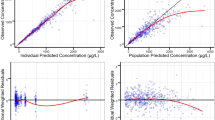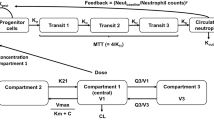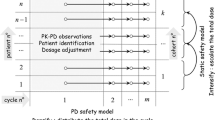Abstract
Aims
To investigate the population pharmacokinetics and pharmacodynamics of doxorubicin and cyclophosphamide in breast cancer patients.
Patients and methods
Sixty-five female patients with early or advanced breast cancer received doxorubicin 60 mg/m2 over 15 minutes followed by cyclophos-phamide 600 mg/m2 over 15 minutes. The plasma concentration-time data of both drugs were measured, and the relationship between drug pharmacokinetics and neutrophil counts was evaluated using nonlinear mixed-effect modelling. Relationships were explored between drug exposure (the area under the plasma concentration-time curve [AUC]), toxicity and tumour response.
Results
Fifty-nine patients had complete pharmacokinetic and toxicity data. In 50 patients with measurable disease, the objective response rate was 60%, with complete responses in 6% of patients. Both doxorubicin and cyclophosphamide pharmacokinetics were associated with neutrophil toxicity. Cyclophosphamide exposure (the AUC) was significantly higher in patients with at least stable disease (n = 44) than in patients with progressive disease (n = 6; 945 μmol ∙ h/L [95% CI 889, 1001] vs 602 μmol ∙ h/L [95% CI 379, 825], p = 0.0002). No such correlation was found for doxorubicin. Body surface area was positively correlated with doxorubicin clearance; AST and patient age were negatively correlated with doxorubicin clearance; creatinine clearance was positively correlated with doxorubicinol clearance; and occasional concurrent use of carbamazepine was positively correlated with cyclophosphamide clearance.
Conclusions
The proposed inhibitory population pharmacokinetic-pharmacodynamic model adequately described individual neutrophil counts after administration of doxorubicin and cyclophosphamide. In this patient population, exposure to cyclophosphamide, as assessed by the AUC, might have been a predictor of the treatment response, whereas exposure to doxorubicin was not. A prospective study should validate cyclophosphamide exposure as a predictive marker for the treatment response and clinical outcome in this patient group.











Similar content being viewed by others
References
Beslija S, Bonneterre J, Burstein H, et al. Second consensus on medical treatment of metastatic breast cancer. Ann Oncol 2007; 18: 215–25
Nabholtz JM, Falkson C, Campos D, et al. Docetaxel and doxorubicin compared with doxorubicin and cyclophos-phamide as first-line chemotherapy for metastatic breast cancer: results of a randomized, multicenter, phase III trial. J Clin Oncol 2003; 21(6): 968–75
Biganzoli L, Cufer T, Bruning P, et al. Doxorubicin and pacli-taxel versus doxorubicin and cyclophosphamide as first-line chemotherapy in metastatic breast cancer: the European Organization for Research and Treatment of Cancer 10961 multicenter phase III trial. J Clin Oncol 2002; 20(14): 3114–21
Jones SE, Clark G, Koleszar S, et al. Adjuvant chemotherapy with doxorubicin and cyclophosphamide in women with rapidly proliferating node-negative breast cancer. Clin Breast Cancer 2002; 3(2): 147–52
Fumoleau P, Chauvin F, Namer M, et al. Intensification of adjuvant chemotherapy: 5-year results of a randomized trial comparing conventional doxorubicin and cyclophosphamide with high-dose mitoxantrone and cyclophosphamide with filgrastim in operable breast cancer with 10 or more involved axillary nodes. J Clin Oncol 2001; 19(3): 612–20
Evans TR, Yellowlees A, Foster E, et al. Phase III randomized trial of doxorubicin and docetaxel versus doxorubicin and cyclophosphamide as primary medical therapy in women with breast cancer: an Anglo-Celtic Cooperative Oncology Group study. J Clin Oncol 2005; 23(13): 2988–95
Smith RE, Anderson SJ, Brown A, et al. Phase II trial of doxorubicin/docetaxel/cyclophosphamide for locally advanced and metastatic breast cancer: results from NSABP trial BP-58. Clin Breast Cancer 2002; 3(5): 333–40
Romond EH, Perez EA, Bryant J, et al. Trastuzumab plus adjuvant chemotherapy for operable HER2-positive breast cancer. N Engl J Med 2005; 353(16): 1673–84
Slamon D, Eiermann W, Robert N, et al. Phase III randomized trial comparing doxorubicin and cyclophosphamide followed by docetaxel (AC-T) with doxorubicin and cyclophosphamide followed by docetaxel and trastuzumab (AC-T) with docetaxel, carboplatin and trastuzumab (TCH) in HER2 positive early breast cancer patients: BCIRG 006 study [abstract]. Breast Cancer Res Treat 2005; 94 Suppl. 1: 5
Twelves CJ, Dobbs NA, Gillies HC, et al. Doxorubicin pharma-cokinetics: the effect of abnormal liver biochemistry tests. Cancer Chemother Pharmacol 1998; 42(3): 229–34
Freyer G, Tranchand B, Ligneau B, et al. Population pharma-cokinetics of doxorubicin, etoposide and ifosfamide in small cell lung cancer patients: results of a multicentre study. Br J Clin Pharmacol 2000; 50(4): 315–24
Rudek MA, Sparreboom A, Garrett-Mayer ES, et al. Factors affecting pharmacokinetic variability following doxorubicin and docetaxel-based therapy. Eur J Cancer 2004; 40(8): 1170–8
Robert J, Armand JP, Huet S, et al. Pharmacokinetics and metabolism of 4′-iodo-4′-deoxy-doxorubicin in humans. J Clin Oncol 1992; 10(7): 1183–90
de Jonge ME, Huitema AD, Rodenhuis S, et al. Clinical pharma-cokinetics of cyclophosphamide. Clin Pharmacokinet 2005; 44(11): 1135–64
de Jonge ME, Huitema AD, Beijnen JH, et al. High exposures to bioactivated cyclophosphamide are related to the occurrence of veno-occlusive disease of the liver following high-dose chemotherapy. Br J Cancer 2006; 94(9): 1226–30
Ayash LJ, Wright JE, Tretyakov O, et al. Cyclophosphamide pharmacokinetics: correlation with cardiac toxicity and tumor response. J Clin Oncol 1992; 10(6): 995–1000
Friberg LE, Henningsson A, Maas H, et al. Model of chemotherapy-induced myelosuppression with parameter consistency across drugs. J Clin Oncol 2002; 20(24): 4713–21
Ratain MJ, Robert J, van der Vijgh WJ. Limited sampling models for doxorubicin pharmacokinetics. J Clin Oncol 1991 May; 9(5): 871–6
van Asperen J, van Tellingen O, Beijnen JH. Determination of doxorubicin and metabolites in murine specimens by highperformance liquid chromatography. J Chromatogr B Biomed Sci Appl 1998; 712(1–2): 129–43
Egorin MJ, Forrest A, Belani CP, et al. A limited sampling strategy for cyclophosphamide pharmacokinetics. Cancer Res 1989 Jun 1; 49(11): 3129–33
Huitema ADR, Tibben MM, Kerbusch T. Simulataneous determination of N,N′,N″-triethylenethiphosphoramide, cyclophos-phamide and some of their metabolites in plasma using capillary gas chromatography. J Chromatogr B Biomed Sci Appl 1998; 716: 177–86
Beal SL, Sheiner LB. NONMEM user’s guide. San Francisco (CA): University of California NONMEM Project Group, 1998
Jonsson EN, Karlsson MO. Xpose — an S-Plus based population pharmacokinetic/pharmacodynamic model building aid for NONMEM. Comput Methods Programs Biomed 1999; 58(1): 51–64
Joerger M, Huitema AD, Meenhorst PL, et al. Pharmacokinetics of low-dose doxorubicin and metabolites in patients with AIDS-related Kaposi sarcoma. Cancer Chemother Pharmacol 2005; 55(5): 488–96
Friberg LE, Freijs A, Sandstrom M, et al. Semiphysiological model for the time course of leukocytes after varying schedules of 5-fluorouracil in rats. J Pharmacol Exp Ther 2000; 295(2): 734–40
Sandstrom M, Lindman H, Nygren P, et al. Model describing the relationship between pharmacokinetics and hematologic toxicity of the epirubicin-docetaxel regimen in breast cancer patients. J Clin Oncol 2005; 23(3): 413–21
Palle J, Frost BM, Peterson C, et al. Doxorubicin pharmacokinetics is correlated to the effect of induction therapy in children with acute myeloid leukemia. Anticancer Drugs 2006; 17(4): 385–92
McDonald GB, McCune JS, Batchelder A, et al. Metabolism-based cyclophosphamide dosing for hematopoietic cell transplant. Clin Pharmacol Ther 2005; 78(3): 298–308
Petros WP, Broadwater G, Berry D, et al. Association of highdose cyclophosphamide, cisplatin, and carmustine pharma-cokinetics with survival, toxicity, and dosing weight in patients with primary breast cancer. Clin Cancer Res 2002; 8(3): 698–705
Belfayol-Pisante L, Guillevin L, Tod M, et al. Pharmacokinetics of cyclophosphamide (CP) and 4-OH-CP/aldophosphamide in systemic vasculitis. Fundam Clin Pharmacol 2000; 14(4): 415–21
Chen TL, Kennedy MJ, Anderson LW, et al. Nonlinear pharma-cokinetics of cyclophosphamide and 4-hydroxycyclophos-phamide/aldophosphamide in patients with metastatic breast cancer receiving high-dose chemotherapy followed by autolo-gous bone marrow transplantation. Drug Metab Dispos 1997; 25(5): 544–51
Sladek NE, Doeden D, Powers JF, et al. Plasma concentrations of 4-hydroxycyclophosphamide and phosphoramide mustard in patients repeatedly given high doses of cyclophosphamide in preparation for bone marrow transplantation. Cancer Treat Rep 1984; 68(10): 1247–54
de Jonge ME, Huitema AD, van Dam SM, et al. Population pharmacokinetics of cyclophosphamide and its metabolites 4-hydroxycyclophosphamide, 2-dechloroethylcyclophos-phamide, and phosphoramide mustard in a high-dose combination with thiotepa and carboplatin. Ther Drug Monit 2005; 27(6): 756–65
de Jonge ME, Huitema AD, van Dam SM, et al. Significant induction of cyclophosphamide and thiotepa metabolism by phenytoin. Cancer Chemother Pharmacol 2005; 55(5): 507–10
Dobbs NA, Twelves CJ, Gillies H, et al. Gender affects doxo-rubicin pharmacokinetics in patients with normal liver biochemistry. Cancer Chemother Pharmacol 1995; 36(6): 473–6
Mross K, Mayer U, Hamm K, et al. Pharmacokinetics and metabolism of iodo-doxorubicin and doxorubicin in humans. Eur J Clin Pharmacol 1990; 39(5): 507–13
Li J, Gwilt PR. The effect of age on the early disposition of doxorubicin. Cancer Chemother Pharmacol 2003; 51(5): 395–402
Acknowledgements
This study was part of the Biomed Project: Population Pharmacokinetic/Pharmacodynamic Analysis of Anticancer Drug Treatment (PL96-2333). The coordinator was Jan Schellens. The study was performed on behalf of the European Organisation for Research and Treatment of Cancer (EORTC)-Pharmacology and Molecular Mechanisms Group (PAMM) and New Drug Development Group (NDDG). Markus Joerger is supported by a fellowship grant funded by the European Society of Medical Oncology and by a research grant from the Swiss National Science Foundation (PBBSB-102331). The project was supported by a grant from the European Community (Biomed Project PL 96-2333). The authors have no conflicts of interest that are directly relevant to the content of this study.
Author information
Authors and Affiliations
Corresponding author
Rights and permissions
About this article
Cite this article
Joerger, M., Huitema, A.D.R., Richel, D.J. et al. Population Pharmacokinetics and Pharmacodynamics of Doxorubicin and Cyclophosphamide in Breast Cancer Patients. Clin Pharmacokinet 46, 1051–1068 (2007). https://doi.org/10.2165/00003088-200746120-00005
Published:
Issue Date:
DOI: https://doi.org/10.2165/00003088-200746120-00005




